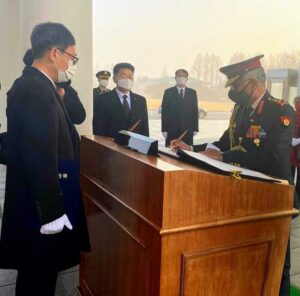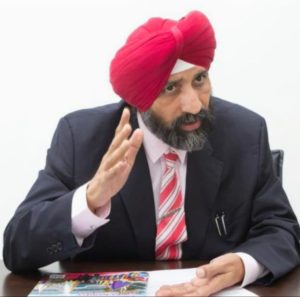India, South Korea defence forces need to plan more cohesively to thwart rising security threats in the region
Indian Army chief General MM Naravane in Seoul: The weakening of USA led security architecture in the Asia Pacific, the increasing aggressiveness of the Chinese navy in the South China Sea, and the emerging transnational security threats in the Indian Ocean are creating new security dilemmas for both South Korea and India.
By Dr. Lakhvinder Singh, Seoul
Indian Army Chief General MM Naravane ‘s ongoing 3-day visit to South Korea from Monday, December 28, 2020, is creating some serious excitement among observers of India Korea defense cooperation as the visit comes at a time when both countries are trying to readjust their foreign and security policies after the change of leadership in the USA. With Trump gone from the scene, both countries are seeking to strengthen their partnership with regional players to face the ongoing power shift in the region successfully and to upgrade their military capabilities to meet the emerging non-conventional security threats in the region.
Given the nature of our armed forces, there is a limit to which our army chief can push our military ties with any foreign country on its own. Being the leader of the disciplined force, he has to operate within the red lines set by our political and diplomatic establishment.
The same is the case of our defense relationship with South Korea. Despite the high potential of cooperation being felt by our armed forces, our defense cooperation has been restricted to very limited areas due to a lack of leadership and decisiveness on the part of our political and diplomatic establishment. As such most of the efforts being made by our defense officials to take the cooperation to next level have not been bearing fruits and are going waste.
Delegation after delegation has visited Seoul in recent years. However, nothing much is changing on the ground. We are witnessing more hype than substance in the India Korea defense cooperation. Today India and Korea stand poles apart in their defense and security perspectives on emerging challenges in the region. Instead of narrowing down, strategic policy gaps between India and Korea are growing by the day. Korea has refused to be part of the USA-led Quadrilateral Security Dialogue (QUAD) which is one of the central premises of India’s security policy for the region. And Korea has become a founding member of China-led emerging free trading block RCEP which India has refused to join.

Thus, most of the defense agreements which are signed during such high-profile visits such as the “military logistics agreement” signed during the visit of defense minister Rajnath Singh to Seoul last year and ‘roadmap for defense industries cooperation’ signed during the South Korean defense minister Jeong Kyeong- doo’s visit to Delhi earlier this year remain on papers only as not much real work is possible because of lack political and strategic consensus on major issues facing the two regions. In the absence of political and strategic alignment, defense agreements signed during these visits are used as ‘ornaments’ by our diplomats to spin and show off the so-called fast-growing relationship between two countries. However, a little closer look into the partnership is revealing the harsh realities of the partnership. Korea and India are moving away from each other by the day.
Currently, nothing seems to be working in India Korea’s strategic partnership. Trade is growing very slow and it seems we will miss the target of 50 billion trade again. India- Korea’s strategic partnership which was supposed to strengthen the overall relationship between two countries has been narrowed down to defense cooperation only. What is worse is that even in defense cooperation it is not focusing on the full spectrum of defense cooperation and instead has been reduced to merely defense industrial cooperation. Sadly, here also it is focused only on one-sided weapons sale from Korea to India. There is very little talk about what India can give and do for Korea in meeting Korea’s defense challenges.
 Today Korea is facing the biggest security challenge in decades in the ever-growing Chinese navy. But unfortunately, so far there is nothing much that our Indian officials could think of to offer to help Korea to meet this ever-growing threat. The bigger vision of India-Korea’s strategic partnership has been completely highjacked by a greedy defense lobby. Damage done to India Korea ties in the last two years or so is irreparable. Most of the Korean scholars who were having big hopes from India Korea defense cooperation are giving up and are moving away. Today most prefer to go to Beijing than Delhi. Game Over?
Today Korea is facing the biggest security challenge in decades in the ever-growing Chinese navy. But unfortunately, so far there is nothing much that our Indian officials could think of to offer to help Korea to meet this ever-growing threat. The bigger vision of India-Korea’s strategic partnership has been completely highjacked by a greedy defense lobby. Damage done to India Korea ties in the last two years or so is irreparable. Most of the Korean scholars who were having big hopes from India Korea defense cooperation are giving up and are moving away. Today most prefer to go to Beijing than Delhi. Game Over?
Related article: Indian Army Chief’s visit to South Korea, Beginning of New Era of India-Korea armed forces partnership: Indian Govt
So, no surprise our army chief‘s current visit is also expected to continue with this “tradition” in India Korea defense ties. According to media reports around $ 3 billion Self Propelled Air Defense Gun Missile System (SPAD-GMS) deal is expected to be part of discussions with Korean defense authorities. In recent years India and South Korea have been in discussions for several military platforms and weapons, especially in naval shipbuilding. South Korean company Daewoo Shipbuilding & Marine Engineering had shown big interest for six advanced conventional submarines under Project-75I (India) and also for KSS-III attack submarine for the Indian Navy.
If everything goes well as planned the project 75I is expected to be processed under the Strategic Partnership Model (SP), and the submarines are planned to build in India through a technology transfer route. Earlier in 2017 south Korean defense firm Hanwha Techwin (HTW) and Indian defense company Larsen & Toubro (L&T) have signed a $720-million deal to produce artillery guns for the Indian Army. K9 Vajra-T, an improved version of HTW’s K9 Thunder has been specially designed to meet the Indian army’s requirements, especially in desert formations. Our army chief’s visit to the Korea Combat Training Centre in Inje and the Agency for Defense Development (ADD) at Daejeon is aimed to strengthen this cooperation further.
Unfortunately, the glare of these so-called big defense deals is blurring the eyes of our officials as they are not able to see the big picture emerging around them. Everything else has been set aside. Today India and Korea face big challenges to their national survival as independent and democratic nations. The weakening of USA-led security architecture in the Asia Pacific, increasing aggressiveness of the Chinese navy in the South China Sea, and emerging translational security threats in the Indian Ocean are creating new security dilemmas for both South Korea and India. Instead of developing a multi-dimensional approach to face these common challenges, our official has resorted to gimmickry. India-Korea’s defense industrial cooperation has no future until both countries are able to reach broader political and diplomatic consensus about their future strategic vision for the region. There is an urgent need to work on that front. First thing first. Thus, while our diplomats are busy spinning “fast-growing India Korea defense ties” Korea is slipping away. Indian officials stand warned.
About the author:

A Seoul-based geo-strategist and an authority on global affairs, Dr. Lakhvinder Singh is part of a think tank in Seoul. He has been living in Korea for the last 23 years and working relentlessly for strengthening the powerful defense partnership between India and Korea. He heads the Asia Pacific Business and Technology Report, India Korea Business and Policy Forum, Punjabi Association of Korea, and the Korea Peace Movement.



